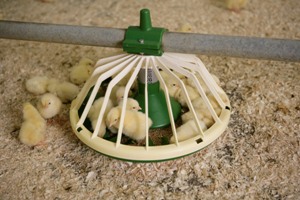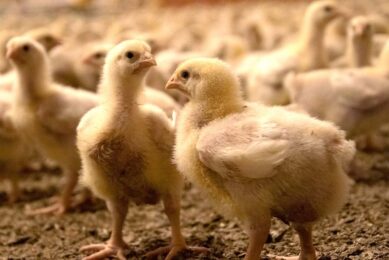Probiotics protect against pathogens

The use of antibiotics in poultry production is under growing pressure. As a result, there are enhanced opportunities of including probiotics in poultry diets. Understanding the biological mechanisms of these microorganisms explains their efficacy.
By Biomin, Austria
Probiotics are live microorganisms that can be incorporated in animal or human diets in order to populate the intestine and/or modulate the conditions within the gastrointestinal tract. This is particularly important in young animals in which stable intestinal bacteria have not yet been established. By adding probiotics in feed or water the intestine is populated with beneficial bacteria avoiding or decreasing the extent of pathogen colonisation. The efficacy of different probiotics has been demonstrated in humans, fish and in animals such as poultry. Because antibiotics are being removed from the routine practices of animal husbandry, probiotics are now being considered as promising tools to fight pathogens.
Proposed mechanisms
There are several proposed mechanisms that explain the mode of action of probiotics against pathogens. Among them, competitive exclusion has obtained much popularity over the last years. Competitive exclusion refers to the blockage of cellular receptors on the luminal surface of epithelial cells, mechanically avoiding the entrance of pathogens. This can be supported by in vitro assays that show the capacity of selected probiotic bacteria to adhere to intestinal cells. Remarkably, the ability to attach to the surface of intestinal cells varies among different strains of the same species of bacteria. Competitive exclusion also considers the consumption of available nutrients by beneficial bacteria limiting resources and space for pathogenic bacteria.
There are several proposed mechanisms that explain the mode of action of probiotics against pathogens. Among them, competitive exclusion has obtained much popularity over the last years. Competitive exclusion refers to the blockage of cellular receptors on the luminal surface of epithelial cells, mechanically avoiding the entrance of pathogens. This can be supported by in vitro assays that show the capacity of selected probiotic bacteria to adhere to intestinal cells. Remarkably, the ability to attach to the surface of intestinal cells varies among different strains of the same species of bacteria. Competitive exclusion also considers the consumption of available nutrients by beneficial bacteria limiting resources and space for pathogenic bacteria.
Intestinal pH reduction
Along with the popular theory of competitive exclusion, other mechanisms for the probiotic-induced inhibition of pathogens have been studied. This is the case of intestinal pH reduction by the production and secretion of metabolites such as acetic and lactic acids. It has been suggested that lactic acid produced by probiotic strains increases permeability in the outer membrane of Gram-negative bacteria facilitating the diffusion of antimicrobial compounds produced by probiotics and by the host’s epithelium. Another mechanism that reduces bacterial viability is the production of harmful substances that specifically target pathogens, like H2O2 and bacteriocins. Bacteriocins are amino acidic molecules that have bactericidal properties on genetically related organisms. Several bacteriocins have been identified already; small bacteriocins tend to be heat-stable whereas large bacteriocins tend to be heat-labile.
Along with the popular theory of competitive exclusion, other mechanisms for the probiotic-induced inhibition of pathogens have been studied. This is the case of intestinal pH reduction by the production and secretion of metabolites such as acetic and lactic acids. It has been suggested that lactic acid produced by probiotic strains increases permeability in the outer membrane of Gram-negative bacteria facilitating the diffusion of antimicrobial compounds produced by probiotics and by the host’s epithelium. Another mechanism that reduces bacterial viability is the production of harmful substances that specifically target pathogens, like H2O2 and bacteriocins. Bacteriocins are amino acidic molecules that have bactericidal properties on genetically related organisms. Several bacteriocins have been identified already; small bacteriocins tend to be heat-stable whereas large bacteriocins tend to be heat-labile.
While the currently described bacteriocins are mostly effective against Gram-positive bacteria there are some bacteriocins already described which are effective against Gram-negative organisms. Because of their amino acidic origin, bacteriocins are susceptible to proteolytic enzymes. There is another group of non-acid substances that are resistant to heat and proteolytic enzymes and thus belong to a different category of inhibitory compounds produced by commensal bacteria. Most of these are not fully identified compounds but with established inhibitory activity against Clostridium, Bacteroides, Bifidobacterium, Enterobacteriaceae, Pseudomonas, Staphylococcus, and Streptococcus.
Sterile intestinal tract
Stimulation of the immune system is another theory that explains the efficacy of probiotics. The intestinal tract of newborns is sterile. Bacteria that first colonise the gut influence the gene expression of epithelial cells, in turn influencing the subsequent bacterial colonisation of the intestine. As an immune organ, the intestine has a large component of lymphoid tissue (GULT; gut-associated lymphoid tissue) which also needs proper stimulation from commensal microorganisms for maturation. Actually, anti-clostridial natural IgA (antibodies that are produced without exposure to the pathogen) secretion is increased in chickens that have been stimulated with probiotics in the diet.
On the other hand, the intestine must also peacefully coexist with commensal bacteria and antigens of alimentary origin (oral tolerance). In addition, non pathogenic bacteria are able to send stimulatory signals to the enterocytes which limit the production of pro-inflammatory cytokines while promoting the production of anti-inflammatory cytokines. This observation can be supported by germ-free mice that show continuous inflammation and inadequate immune responses against normal dietary antigens.
Strain specific
It should be noticed that the immune-stimulatory function of commensal bacteria is strain specific and even closely related bacteria stimulate the immune system in different ways. Theoretically, probiotics could achieve benefits by either pro- or anti-inflammatory effects. For example in human medicine it could be desired to reduce inflammation in patients undergoing chronic inflammation (Crohn’s disease). On the other hand, enhanced inflammation and direction of the immune system towards the cellular component of the immune response may help fighting coccidia in poultry. Controlling coccidiosis with probiotics or other natural substances is receiving considerable attention due to the proposed date (2013) for the banning of anticoccidials products for animal production in the European Union. So far no promising results have been achieved.
It should be noticed that the immune-stimulatory function of commensal bacteria is strain specific and even closely related bacteria stimulate the immune system in different ways. Theoretically, probiotics could achieve benefits by either pro- or anti-inflammatory effects. For example in human medicine it could be desired to reduce inflammation in patients undergoing chronic inflammation (Crohn’s disease). On the other hand, enhanced inflammation and direction of the immune system towards the cellular component of the immune response may help fighting coccidia in poultry. Controlling coccidiosis with probiotics or other natural substances is receiving considerable attention due to the proposed date (2013) for the banning of anticoccidials products for animal production in the European Union. So far no promising results have been achieved.
Indigenous bacteria helpful
In addition to the anti-pathogenic activity that probiotics have, it has been demonstrated that indigenous bacteria of the intestine also contribute to the healthy development of epithelial cells. Actually, indigenous bacteria can stimulate enterocytes to produce and release active gastrointestinal peptides that impact the regulation of epithelial structure and intestinal endocrine cells. It is also becoming clear that commensal bacteria modulate gene expression of epithelial cells influencing nutrient absorption, intestinal maturation and improvement of the mucosal barrier.
In addition to the anti-pathogenic activity that probiotics have, it has been demonstrated that indigenous bacteria of the intestine also contribute to the healthy development of epithelial cells. Actually, indigenous bacteria can stimulate enterocytes to produce and release active gastrointestinal peptides that impact the regulation of epithelial structure and intestinal endocrine cells. It is also becoming clear that commensal bacteria modulate gene expression of epithelial cells influencing nutrient absorption, intestinal maturation and improvement of the mucosal barrier.
Interestingly, some strains of Lactobacillus are able to reduce the epithelial invasion of enterohemorrhagic E. coli (EHEC) without decreasing the viability of the pathogen. Since this effect is only observed with live Lactobacillus it is thought that it is the result of the interaction of commensal bacteria and intestinal epithelium that induces protective changes on the enterocytes interfering with the internalisation process of EHEC.
MORE INFORMATION References are available from Biomin www.biomin.net |
Join 31,000+ subscribers
Subscribe to our newsletter to stay updated about all the need-to-know content in the poultry sector, three times a week. Beheer
Beheer








 WP Admin
WP Admin  Bewerk bericht
Bewerk bericht